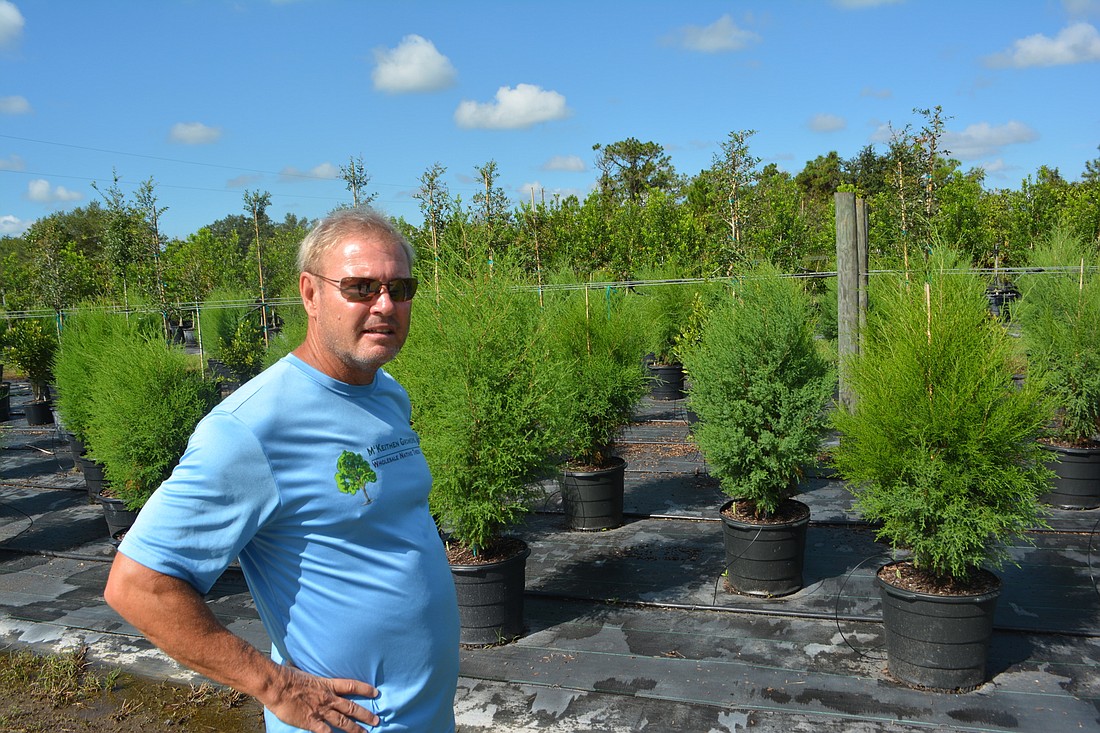- April 27, 2024
-
-
Loading

Loading

Patricia McKeithen remembers the early days and her dates with Eddie McKeithen, who for the past 27 years has been her husband.
"We would be driving down the road," Patricia remembered. "Then his head would spin around. Whoa! Whoa!"
Patricia's head would then spin around, too, as she looked to see if he was checking out a young lady with a nice figure.
"No, he was looking at trees," Patricia said. "He would say, 'Look at the canopy on that one.'"
Since 1995, Patricia and Eddie have owned McKeithen Growers in Myakka City. It appears Patricia was barking up the right tree.
"I was in Cincinnati recently and I was riding with a friend," she said. "I was looking up and she was looking at me to see what I was looking at."
She was admiring the trees.
Those who had known Patricia pre-Eddie probably wondered what had happened to the friend they once knew. That friend wouldn't have known an oak from a maple.
Now she bleeds sap just like her husband.
Besides building McKeithen Growers into a success story — they sell over 100,000 trees a year from their 25 acres — she has branched out when it comes to sharing her husband's passion — native trees and plants.
Both are now members of the Florida Association of Native Nurseries (FANN).
Native trees are McKeithen Growers' niche and one they are proud to support. The farm grows 60-plus varieties of native trees and shrubs.
Eddie, now 56, grew up in St. Petersburg, but has lived in Manatee County since 1984. He earned a degree in forestry and geology from the University of the South in Sewanee, Tenn., and headed home to work at his brother Ken's SunBay Nursery in Bradenton. Eventually, he wanted to wanted to start his own farm.
Eventually, he purchased his current site.
"Lakewood Ranch really didn't exist in 1995," he said. "You had Braden Woods and Braden Pines and not much else. When my wife and I moved out here, we were thinking 'This is supposed to be a (future) city?'"
But the area took off and so did McKeithen Growers, albeit as a place that stressed native plants even as truckloads of nonnative palms were arriving each day.
"Sustainable just makes sense and I was burned out on the palms," he said. "With natural trees, and native plants in general, you are not having to spray as much, and you aren't worried about chemicals. It makes my job as a grower easier and it translates to the customer."
With native trees, Eddie said you might have to spray or fertilize them a bit when they are planted and once they are established, nothing else is needed.
As time passed, landscapers were facing more regulations to plant native plants when they were planning new developments. Eddie said that's a good thing.
"A few bad freezes and people will be saying, 'Hey, my palm looks terrible.'"
Although the sabal palm is the Florida State tree, most palms planted around my own yard are not native. Eddie also gave me some bad news. Those hibiscus I have planted all over the place aren't native, either.
East of the interstate, it gets colder than it does on the coast," he said. "Hibiscus are cold sensitive. It's not a matter of if they will freeze, but when."
Eddie suggested I attend The Native Plant Show Oct. 18-19 at the Bradenton Area Convention Center in Palmetto. The upcoming show marks the first time it will be open to the public instead of just industry professionals. Those who want to learn about the benefits of native plants and trees will have a gold mine of resources made available to them.
Opening the show to the public is great news to the McKeithens, who try to spread education about native plants whenever they can.
Those who wonder about the importance of the topic might consider all the Australian pines that had been planted along State Road 64 near its intersection with Lakewood Ranch Boulevard. Hurricane Irma ripped all those nonnative trees up by the roots because they weren't able to withstand the elements.
Eddie also noted you see a lot of nonnative trees at the beaches because they are pretty. They just don't last long, or look good after they begin to suffer.
"The trend now is to use the right tree in the right spot," he said. "Sometimes trees are put into an area too small for them. The homeowner has to be aware."
An example is an oak planted too close to a driveway, which eventually breaks up by the growth of the roots.
He also noted he recently saw royal palms planted next to parking spaces. Their huge palm fronds can fall on the cars and do damage.
A nonnative tree, the Washingtonia palm, often is planted in the area but it grows too tall and can be hard to trim.
The Native Plant Show offers landscape architects who can educate the public on proper practices.
For those who wonder, Eddie's top five sellers are the live oak, red maple, southern magnolia, southern red cedar and bald cypress.
And if you want to know more about those trees, just ask Patricia.